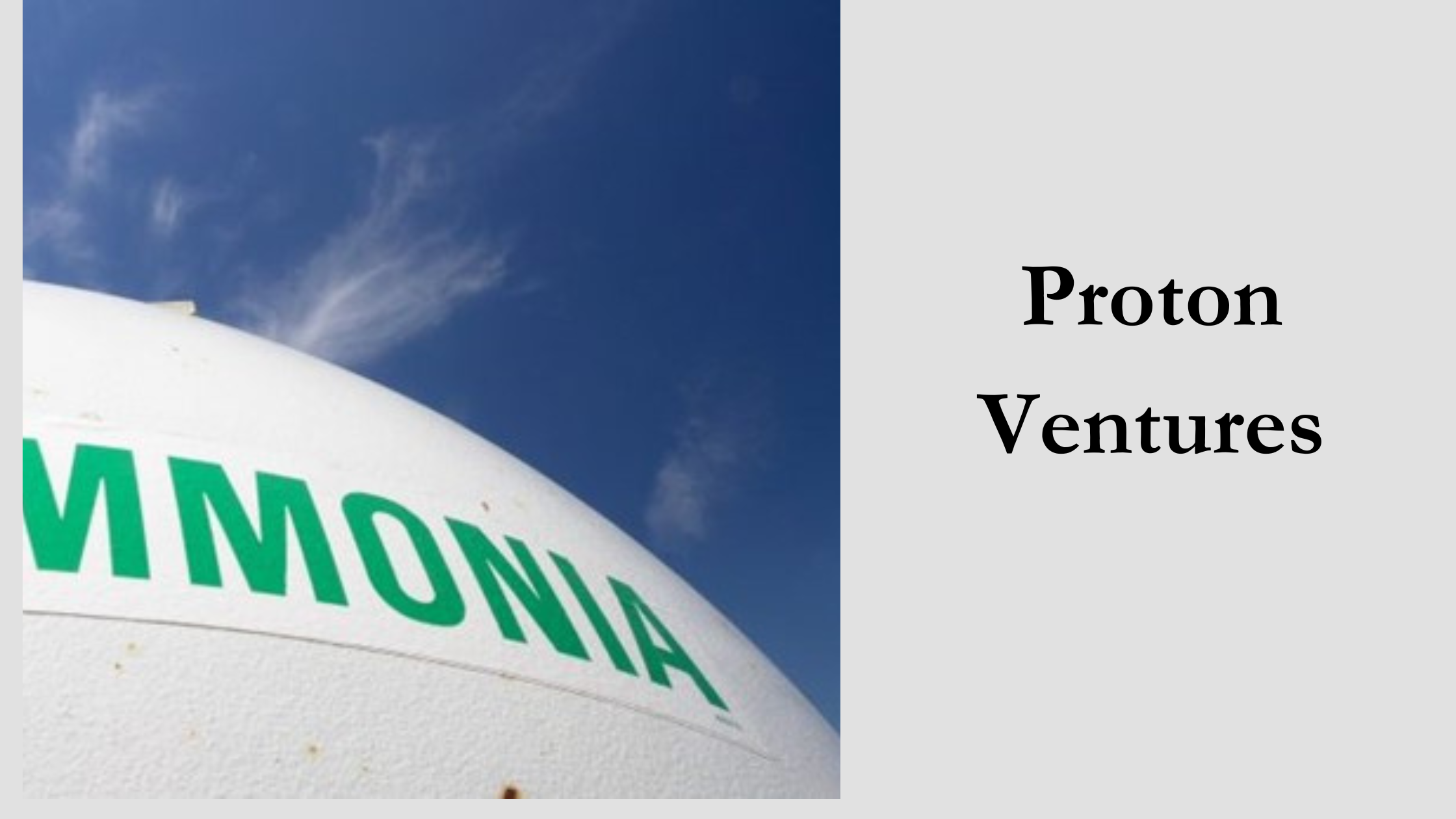In the green ammonia sector, Proton Ventures offers engineering solutions. Former CEO Hans Vrijenhoef, who had previously served as the plant manager of an abandoned ammonia plant in Rozenburg, the Netherlands, launched the business in 2001. Vrijenhoef had the idea to use ammonia as a zero-carbon fuel and hydrogen carrier early on. Twenty years later, thanks to worldwide initiatives to lessen the effects of climate change caused by humans, we see that vision becoming a reality.
In this developing field, Proton Ventures is involved in a fair number of projects, including scoping studies, feasibility analyses, front end engineering designs (FEEDs), and engineering, procurement, and construction (EPC) projects. Proton Ventures’ ability to identify the best licensors, technology suppliers, and original equipment manufacturers for each unique project thanks to its technology-agnostic system integrator strategy is one of its defining features.
Manufacture Of Green Ammonia For Use In Fertilizers
Production of green ammonia has been a major area of concentration for Proton Ventures over its 20-year history. Proton Ventures has historically concentrated on modular ammonia plants with a production capacity in the range of 3 to 60 MT per day of ammonia, as opposed to world-scale ammonia facilities producing up to one million tonnes per year. This makes it possible to put ammonia factories next to modular electrolyzers with wind and solar photovoltaic (PV) power capacity. The modular design enhances flexibility throughout the entire ammonia plant.
An industrial-scale, 4-MT-per-day Green Ammonia Pilot Plant (GAPP) is now being built at the OCP Group chemical complex in Jorf Lasfar, Morocco, as part of an EPC project being carried out by Proton Ventures. Both a two megawatt (MW) alkaline electrolyser and a two MW proton exchange membrane (PEM) electrolyser will be used in this pilot plant to produce hydrogen, store compressed hydrogen, purify nitrogen, and run a Haber-Bosch ammonia synthesis loop. The emulator, which can mimic intermittent electricity profiles from any probable place in the world and send this profile to the electrolyser system, is another important component of the project. This facility will afterwards enable the de-risking of substantial green ammonia projects. The Mohammed VI Polytechnic University will run the facility after the first year of operation by Proton Ventures, so that future engineers in the green ammonia business will already have received training during their formal education.
Creation Of Large-Scale Green Ammonia Production Projects
Proton Ventures is also involved in the TransHydrogen Alliance, which wants to create ammonia in countries with a lot of solar and wind resources, like Brazil and Morocco, and then transport it to Rotterdam, the Netherlands, where it may be cracked into hydrogen. The goal of this project is to produce ammonia on a bigger scale, starting with one million metric tonnes annually and going beyond that. The TransHydrogen Alliance has the advantage of coupling production and use, securing supply while minimizing system costs overall.
A partnership agreement with the TransHydrogen Alliance was signed in February 2023 by Casa dos Ventos and Comerc Eficiência, a firm specializing in renewable energy efficiency and a member of the Comerc Energia Group. The agreement’s main goal is to make it possible to export green ammonia made at the Ceará state’s Industrial and Port Complex of Pecém (CIPP). The facility will be constructed on a 60-hectare location and have an electrolysis capacity of up to 2.4 GW, producing 960 tonnes of hydrogen daily. The plant will produce 2.2 million tonnes of ammonia annually once all phases have been completed. The parties agreed to work together to create a successful collaboration with the goal of producing the first phase and exporting it to Europe via the Port of Rotterdam in 2027.
Commercial initiatives like the ones described above primarily rely on current technology. Proton Ventures, however, also works on cutting-edge ammonia synthesis techniques and solutions, such as revolutionary electrolyser technologies. Enhancing electrolysis-based hydrogen generation is essential because ammonia production normally requires at least 90% of that energy. The Battolyser, which combines an iron-nickel battery and an alkaline-type electrolyser, was developed with the help of Proton Ventures from a university research lab to a stand-alone business. Proton Ventures has also received a patent for a low-pressure ammonia synthesis method used in the EU project ARENHA. This method can greatly increase single pass conversion through the use of a sorbent-enhanced separation step. Construction on the demonstration plant is presently underway.
Storage And Handling Of Ammonia
The refrigerated storage tanks in Estonia (BCT) and Bulgaria (Agropolychim), which are among the biggest working ammonia storage tanks in Europe, are among the most important projects created by Proton Ventures. For instance, each of the two tanks in Estonia can store 30 kt of chilled ammonia at -33°C. The double containment storage tanks meet current safety regulations. The facilities in Estonia additionally include four 20 kt UAN tanks, a marine loading arm facility, and train loading and unloading systems. Through the engineering and design skills of Proton Ventures, full containment storage tanks can also be realized.
As ammonia is utilized more frequently as a hydrogen carrier, a stationary fuel, and a shipping fuel, the global trade in green ammonia is anticipated to grow tremendously during the ensuing decades. In order to accommodate this need, ammonia import and export terminal developments have significantly increased. Proton Ventures and different consortia partners have been awarded multiple contracts to design and/or build cutting-edge terminals all around the world as a result of these breakthroughs, including:
- a complete EPC agreement with OCP Group for two new transfer lines and chilled ammonia storage tanks at Jorf Lasfar, Morocco;
- The FEED for the renovation of two storage tanks and related (off)loading infrastructure run by Vesta Terminals in Vlissingen, the Netherlands, is currently being carried out by Proton Ventures;
- A feasibility study for a new ammonia export terminal with floating port infrastructure at Oakajee, Australia, is being carried out through the Port of Rotterdam.
Even when they are situated in arid regions where temperatures can occasionally exceed 50°C, Proton Ventures complies with modern specifications for new green ammonia storage tanks. A new ammonia export terminal in the United Arab Emirates has received an extended FEED package. A customized main discharge bottom valve for inherent safety is one illustration. Intermittent flaring and a connecting bridge with a combined staircase between the two storage tanks are used to connect them while maximizing capital investment, space utilization, and simplicity. Additionally, the refrigeration system is designed with operations in hot climates and low operational costs in mind.
Proton Ventures was also invited to join the working group that will update the PGS-12 (Publication series Dangerous Substances) by VOTOB, The Dutch Association of Tank Storage Companies. The PGS-12, the component devoted to ammonia storage and handling, will be improved by the four-chair committee, which includes representatives from Vopak, OCI, Yara International, and Proton Ventures. The safety requirements for ammonia terminals and offloading facilities in the Netherlands are rising as a result of the import of significant amounts of hydrogen in the form of green ammonia. The PSG-12’s modernization will produce a transparent and unambiguous set of guidelines for more, bigger, and safer ammonia terminals in the Netherlands.
Proton Ventures has been a proud representative of PGS-12 both domestically and internationally, using the PGS-12 standard to develop secure and cutting-edge ammonia terminals across Europe, the Middle East, and Africa.
Carbon Monoxide Emissions
Nitrogen oxide emissions need to be reduced when using ammonia as a fuel or to make nitric acid. Eutrophication is primarily a local problem brought on by NOx emissions. The global warming potential (GWP) of nitrous oxide (N2O) emissions, in contrast, is 298 times more than that of carbon dioxide.
The creation of harmless air dinitrogen and water as a result of the reaction between nitrogen oxides and ammonia in a selective catalytic reduction (SCR) system can reduce the amount of nitrogen oxide emissions. The majority of nitric acid plants in the EU have such SCR systems installed, almost eliminating N2O emissions from these facilities. This suggests that it is low hanging fruit in the global endeavor to decarbonize as it is mostly not yet common practice in the rest of the globe.
In order to reduce DeNOx and N2O with an SCR system at a nitric acid factory, Kavala Fertilizers in Greece hired Proton Ventures as an EPC contractor. This DeNOx system complies with the strictest nitrogen oxide emission regulations while saving around 20,000 tonnes of carbon dioxide equivalent emissions yearly. The yellow plume from the nitric acid plant has also been removed thanks to the SCR system.
SCR systems can also be used to convert ammonia for energy purposes, including gas turbines and ship engines. Numerous gas turbines have already installed an SCR system, processing ammonia on-site, and are currently fed with hydrocarbons like natural gas.
Generation Of Hydrogen
Ammonia cracking for massive, environmentally friendly hydrogen production
In a decarbonized energy and food landscape, ammonia is increasingly seen as a zero-carbon fuel and hydrogen carrier. Ammonia’s employment as a hydrogen carrier is expected to rise as it becomes a more common energy vector. Several northern European ports, including Rotterdam and Wilhelmshaven, are currently considering installing ammonia cracking facilities for the manufacture of hydrogen. Proton Ventures continues to be participating in a number of research consortiums and has conducted numerous studies on ammonia cracking for clients. These centralized ammonia cracker systems for producing pure hydrogen are quite comparable to natural gas processing plants for hydrogen production in terms of functionality. Alternately, decentralized ammonia cracker systems have also been created, which do not always call for complete hydrogen conversion and purification. This increases the system’s cost- and energy-efficiency.
Proton Ventures is now running a high-pressure testing facility at the high-pressure laboratory at the Technical University of Twente in the Netherlands to increase the company’s proficiency in ammonia cracking. This is essential for validating operational performance in settings that are applicable to the industrial setting while also enabling the testing of novel cracker concepts. Industrial-grade pilot plants are a crucial intermediate step for the industry to take as it moves toward large-scale hydrogen production facilities, as performance in terms of ammonia feedstock use is crucial for the cost of produced hydrogen. Over 90% of the levelized cost of hydrogen from ammonia cracking can be attributed to the cost of the ammonia feedstock. Therefore, it is crucial to use as little ammonia feedstock as possible. Building specialized experience in the integration of effective processes and technologies at Proton Ventures will help clients and the sector reach the lowest levelized cost of hydrogen.
Setting A Good Example
The green ammonia economy will probably materialize soon. Many greenfield green ammonia facilities are being developed or even built, and numerous decarbonization initiatives for existing ammonia plants have already been realized. This means that numerous consortia are in the process of commercializing ammonia energy solutions.
With the founding of the annual NH3 Event in 2017, the first European conference dedicated to low-carbon ammonia production as well as its usage as a low-carbon fertilizer, zero-carbon fuel, and hydrogen carrier, Proton Ventures has been at the forefront of these advancements.



